Welcome to the Beach Parent’s Guide, your comprehensive resource for ensuring a safe, enjoyable, and memorable beach experience with your family. Discover essential tips, from preparation to engagement, while fostering a deeper connection with nature and each other. This guide helps you navigate challenges, embrace opportunities for learning, and create lasting memories by the sea.
1.1 Understanding the Importance of Beach Safety for Families

Beach safety is crucial for families to ensure a enjoyable and worry-free experience. Understanding potential hazards like rip currents, slippery surfaces, and extreme weather is essential. Sun protection, including sunscreen and hats, prevents sunburn and long-term skin damage; A first aid kit and knowledge of basic first aid can address minor injuries promptly. Supervising children near water and setting clear boundaries helps prevent accidents. Being aware of marine life, such as jellyfish, and knowing how to respond is vital. Teaching kids to swim and stay within designated areas adds an extra layer of security. By prioritizing safety, families can focus on creating memorable moments while protecting their well-being. Preparation and awareness are key to a safe beach day.
1.2 Setting Expectations for a Fun and Safe Beach Day
Setting clear expectations helps create a fun and safe beach experience for everyone. Before heading out, discuss the day’s plans with your family, including activities, safety rules, and what to bring. Explain the importance of staying together and following guidelines like swimming in designated areas. Encourage kids to share their ideas to build excitement and ownership. Balance structured activities with downtime to avoid overstimulation. Emphasize the need for respect—both for others and the environment. By aligning expectations, you can ensure a day filled with laughter, exploration, and memories while minimizing potential challenges. Clear communication and shared goals are key to a successful beach outing.
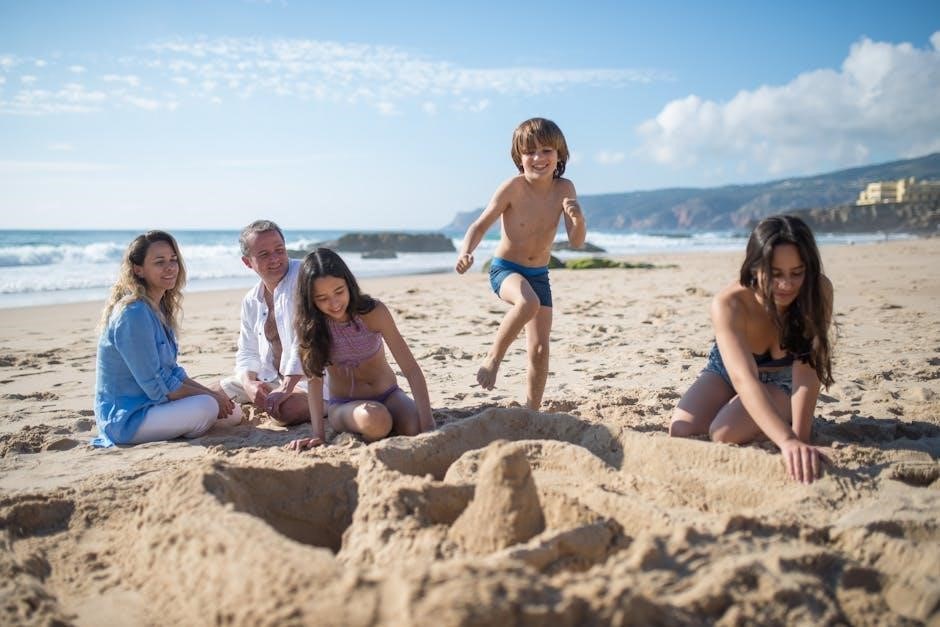
Preparing for the Beach Trip
Preparing for a beach trip involves packing essentials like sunscreen, towels, and snacks. Choose a family-friendly beach with calm waters and amenities. Plan age-appropriate activities to ensure everyone enjoys the day.
2.1 Essential Items to Pack for the Beach
Packing the right items ensures a comfortable and enjoyable beach experience for your family. Start with swimwear, sunscreen, and wide-brimmed hats for sun protection. Bring large, absorbent towels, a beach blanket, and a lightweight, water-resistant cover for extra comfort. Include refillable water bottles to stay hydrated and snacks like fruits, granola bars, and trail mix. A first-aid kit is crucial for minor injuries, along with after-sun lotion for soothing skin. Don’t forget entertainment for kids, such as beach toys, coloring books, and a portable speaker for music. Pack extra clothes, including lightweight rain jackets, and a small shovel for sandcastle building. Finally, bring a reusable bag for carrying all items and avoid single-use plastics to help protect the environment.
2.2 Choosing the Right Beach for Your Family
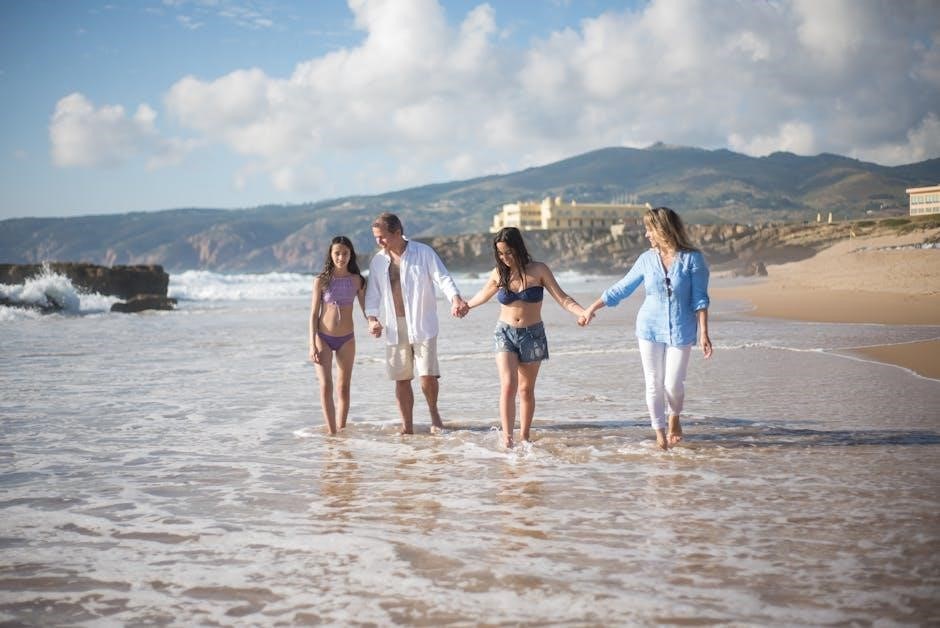
Selecting the right beach for your family is key to ensuring an enjoyable experience for all. Look for beaches with calm waters and shallow areas, ideal for young children to play safely. Amenities like restrooms, showers, and food vendors are convenient and add comfort to your day. Consider beaches with playgrounds or picnic areas to keep kids entertained. Check for lifeguard presence and family-friendly policies. Avoid beaches with strong currents or rough seas, especially if you have little ones. Also, opt for less crowded spots to ensure a more relaxed atmosphere. Finally, choose beaches with easy access and parking to make your trip stress-free. Researching reviews and asking locals can help you find the perfect spot for your family’s needs.
2.3 Planning Activities for All Ages
Planning engaging activities ensures everyone enjoys the beach, regardless of age. For children, consider sandcastle building, treasure hunts, or swimming in shallow waters. Organize games like beach volleyball or frisbee for teens and adults. Bring along books or puzzles for those who prefer relaxation. Introduce educational elements, such as shell collecting or learning about tidal patterns, to spark curiosity. Schedule breaks for snacks and hydration to keep energy levels high. Encourage family bonding through group activities like beach Olympics or storytelling sessions. Don’t forget to include downtime for relaxation, allowing everyone to unwind and recharge. A mix of structured and spontaneous activities ensures a balanced and memorable day for all.
Beach Safety Tips for Parents
Ensure constant supervision near water, teach children to recognize swimming flags, apply sunscreen regularly, and pack a first-aid kit. Stay prepared for emergencies and educate your family on rip currents and sun protection to ensure a safe beach experience.
3.1 Water Safety: Understanding Rip Currents and Swimming Areas
Water safety is paramount for families at the beach. Rip currents are powerful channels of water that can quickly pull swimmers away from the shore. Teach your children to identify rip currents by looking for discolored or foamy water, and instruct them not to panic if caught. Instead, they should swim parallel to the shore until free. Always check for swimming flags and avoid areas marked with red flags, as they indicate dangerous conditions. Encourage children to stay close to designated swimming areas and never swim alone. Consider enrolling kids in swimming lessons to build their water confidence. Lifeguards are essential resources—don’t hesitate to ask for guidance. Staying informed and prepared ensures a safer beach experience for everyone.
3.2 Sun Protection: Sunscreen, Hats, and Shade
Sun protection is crucial for a safe and enjoyable beach day. Apply sunscreen with at least SPF 30 to all exposed skin 15-30 minutes before heading out. Reapply every two hours or after swimming or sweating. Choose broad-spectrum sunscreen to protect against both UVA and UVB rays. Hats with wide brims provide excellent protection for faces, necks, and ears. Opt for lightweight, breathable fabrics and encourage kids to wear them. Shade, such as beach canopies or umbrellas, offers relief from direct sunlight. Seek shade during peak sun hours (10 AM–4 PM) when UV rays are strongest. Don’t forget lip balm with SPF and protective clothing like rash guards for extra coverage. Consistent sun protection helps prevent burns and long-term skin damage, ensuring a comfortable day at the beach.
3.3 First Aid Kit Essentials and Emergency Preparedness
A well-stocked first aid kit is vital for addressing minor injuries and preventing more serious issues. Include bandages, antiseptic wipes, pain relievers, antihistamines, and gloves. Add supplies like tweezers for removing splinters and a cold pack for sprains. Know basic first aid techniques, such as CPR and wound cleaning. Identify the nearest medical facility and keep emergency contact numbers handy. Teach children what to do in case of an accident, like finding a trusted adult or calling for help. Stay aware of your surroundings to prevent accidents, such as slipping on rocks or overexertion. A prepared approach ensures quick, effective responses, keeping your family safe and comfortable throughout the day.

Engaging Kids at the Beach
Transform the beach into a playground of discovery and fun! Use sand for creative sculptures, explore tidal pools for marine life, and engage in games like beach volleyball or treasure hunts. Encourage kids to collect seashells, swim in shallow waters, and learn about nature. These activities foster curiosity, physical activity, and family bonding, making the beach an ideal setting for both entertainment and education.
4.1 Fun Outdoor Activities for Children
Engage your kids in exciting beach activities that blend play with learning. Sandcastle building fosters creativity, while beach volleyball or frisbee encourages physical activity and teamwork. Nature scavenger hunts, where children search for seashells, driftwood, or unique rocks, spark curiosity about the environment. Tidal pool exploration allows them to discover marine life, teaching them about ecosystems. Organize a family treasure hunt with clues or riddles, making the experience both thrilling and educational. These activities not only keep children entertained but also promote bonding and an appreciation for nature. Ensure safety by supervising water play and providing shade for breaks, creating a balanced and enjoyable day for all;
4.2 Educational Opportunities: Marine Life and Nature
The beach offers a wealth of educational opportunities for children, transforming it into an outdoor classroom. Encourage kids to explore and identify marine creatures like crabs, starfish, and anemones in tidal pools. Discuss the importance of tidal patterns, ocean currents, and the water cycle. Teach them about the role of sand dunes in protecting coastlines and preventing erosion. Encourage observation of bird species and their habitats, fostering an appreciation for biodiversity. Use the beach as a space for hands-on learning, where children can classify shells, study wave formations, and understand the interconnectedness of marine ecosystems. These experiences not only educate but also inspire a lifelong love for nature and conservation.
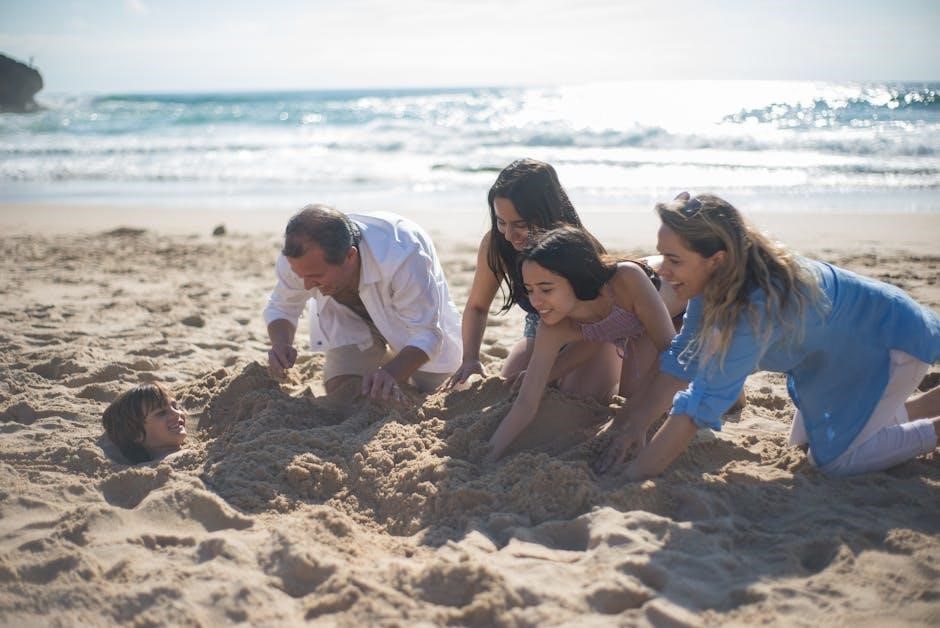
Beach Etiquette for Families
Respect fellow beachgoers by maintaining a clean, considerate space. Teach children to dispose of trash properly and keep noise levels reasonable. Set a positive example for others while enjoying the shore together.
5.1 Respecting Other Beachgoers and Shared Spaces
Respecting other beachgoers and shared spaces is essential for a harmonious beach experience. Always maintain a considerate distance from others to ensure privacy and comfort. Avoid loud noises or disruptive behavior that might disturb those around you. Keep your area clean and refrain from leaving trash behind, as this not only respects others but also protects the environment. Teach children to be mindful of shared spaces and not interfere with others’ belongings or activities. By setting a positive example, you help create a welcoming atmosphere for everyone. Remember, the beach is a shared space, and courtesy goes a long way in ensuring a pleasant day for all families involved.
5.2 Proper Waste Disposal and Environmental Care
Proper waste disposal and environmental care are crucial for preserving the beauty and health of beaches. Always use designated trash bins and recycling containers to dispose of waste. Bring reusable items like water bottles, bags, and food containers to minimize single-use plastics. Avoid leaving hazardous materials, such as batteries or chemicals, on the beach. Educate your children about the importance of keeping the environment clean and how their actions can protect marine life. Encourage them to participate in small clean-up activities, like picking up trash near your spot. By modeling responsible behavior, you teach your family to respect and care for the planet. This ensures a safer, cleaner beach for everyone to enjoy.
Managing Challenges at the Beach
Managing beach challenges involves staying calm during tantrums, using distractions for overstimulation, and preparing for allergies with emergency kits to ensure a smooth day.
6.1 Handling Tantrums and Overstimulation
Handling tantrums and overstimulation at the beach requires patience and preparedness. Stay calm and acknowledge your child’s feelings to help them regulate emotions. Distract with a favorite toy or activity to shift focus. A designated quiet area can provide a break from overwhelming stimuli. Pack snacks and water to prevent hunger-related meltdowns. Set clear expectations beforehand to avoid disappointments. Encourage communication about what’s bothering them, offering reassurance. Sometimes, a short walk or change of scenery can help reset moods. Remember, it’s okay to take a break—your child’s well-being is key to a enjoyable day.
6.2 Dealing with Allergies or Sensitive Skin
For children with allergies or sensitive skin, the beach requires extra precautions. Apply hypoallergenic sunscreen liberally and opt for mineral-based products to avoid irritation. Insect repellents should be used sparingly, and consider protective clothing to prevent bites. Sand can irritate sensitive skin, so gently cleanse with lukewarm water after playtime. Bring a first aid kit with antihistamines or hydrocortisone for allergic reactions. Avoid strong chemicals in beach products and choose fragrance-free options. If your child has specific allergies, inform others and keep emergency contacts handy. Monitor for signs of reactions and consult a pediatrician if needed. With careful planning, your child can enjoy the beach comfortably and safely.
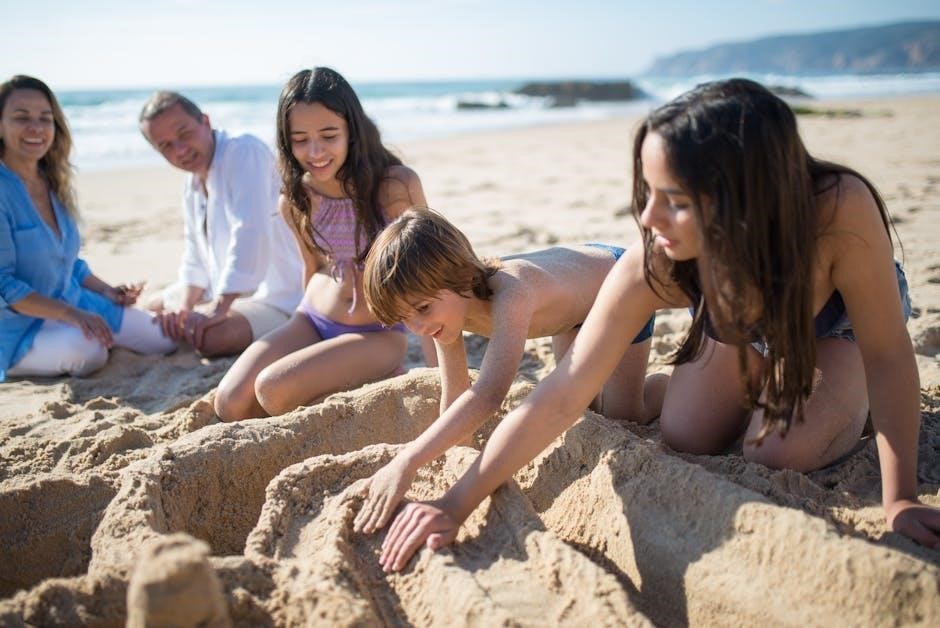
Capturing Memories
Capturing memories at the beach creates lasting family treasures. Use photography tips to snap vibrant moments and create a family beach journal for reflections and mementos.
7.1 Photography Tips for Beach Days
Capturing memories at the beach requires thoughtful photography. Use natural light during the golden hour for stunning shots. Keep compositions simple, focusing on subjects like smiling faces or waves. Experiment with angles, like low shots of sandcastles or birds flying overhead. Don’t forget candid moments of kids playing or family laughter. A polaroid camera adds fun instant memories. Always carry extra batteries and storage. Involve children in taking photos to spark creativity. These tips ensure your beach day photos are vibrant, meaningful, and timeless, preserving your family’s special moments by the sea.
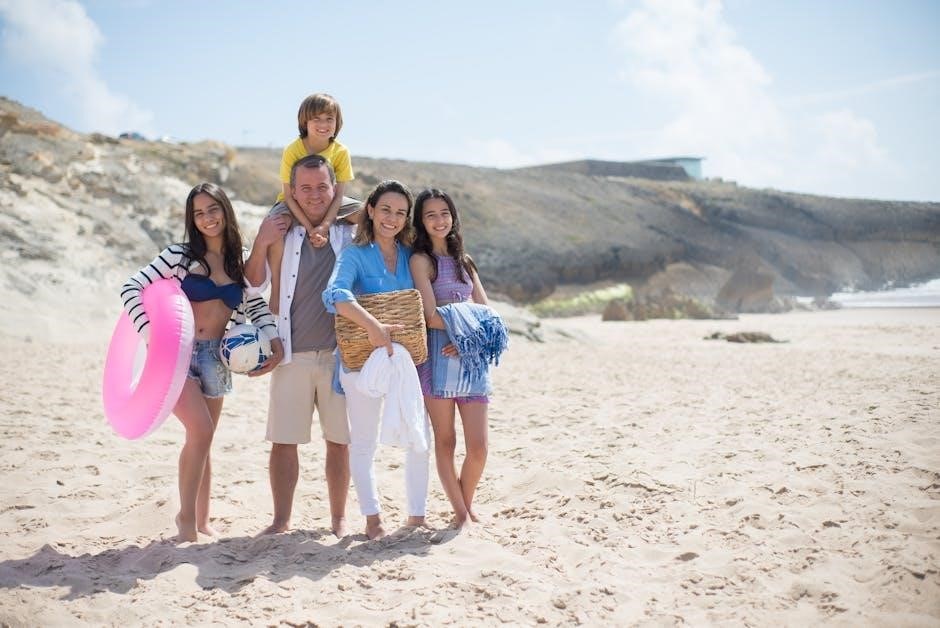
7.2 Creating a Family Beach Journal
A family beach journal is a heartfelt way to document your coastal adventures. Start with a dedicated notebook and encourage everyone to contribute. Include entries like the date, location, and weather, along with sketches or photos. Let kids write or draw about their favorite moments, like building sandcastles or spotting marine life. Add memorabilia like ticket stubs or seashells. Reflect on the day’s highlights and lessons learned. This collaborative project fosters creativity and bonding, becoming a cherished keepsake. By capturing thoughts and memories, your journal will serve as a lasting reminder of your beach experiences and the joy shared together as a family.
Post-Beach Routine
Wind down after your beach day with a refreshing routine. Clean up, hydrate, and reflect on the day’s experiences to ensure a smooth transition back home.
8.1 Cleaning Up and Hydrating After the Beach
After a day at the beach, it’s important to clean up thoroughly and stay hydrated. Rinse off sand and saltwater, and dispose of trash properly. Encourage everyone to drink water to replenish fluids lost from sun exposure. Offer electrolyte-rich snacks or coconut water for added hydration. A warm bath or shower can help remove remaining sand and soothe skin. Clean beach toys and utensils before storing them. Finally, take a moment to relax and reflect on the day’s experiences, ensuring a smooth transition back to routine.
8.2 Reflecting on the Day’s Experiences
Reflecting on the day’s experiences is a wonderful way to unwind and create lasting memories. Encourage your family to share their favorite moments, from building sandcastles to spotting marine life. Discuss what everyone enjoyed most and what they learned. Capturing these reflections in a beach journal or through photos can help preserve the memories. It’s also a great opportunity to teach kids the importance of gratitude and appreciation for nature. Ending the day with a moment of reflection fosters a sense of accomplishment and togetherness, making the beach trip even more meaningful.

